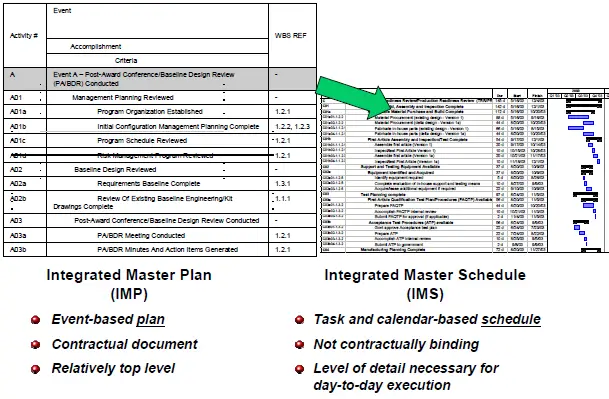The Integrated Master Plan (IMP) is an event-based, top-level plan consisting of a hierarchy of Program Events. Each event is decomposed into specific accomplishments and each specific accomplishment is decomposed into specific Criteria. The IMP is ultimately used to develop a time-based Integrated Master Schedule (IMS) to show a networked, multi-layered schedule showing all the detailed tasks required to accomplish the work effort contained in the IMP. The IMP and IMS are related to the Work Breakdown Structure (WBS). The IMP provides a Program Manager (PM) with a systematic approach to planning, scheduling, and execution.
Definition: The Integrated Master Plan (IMP) is composed of a group of hierarchy program events, in which each program event is supported by Accomplishment, and Criteria to satisfy a specific program goal.
What is the Purpose of the Integrated Master Plan (IMP)
The Integrated Master Plan (IMP) and the Integrated Management System (IMS) both give the Program Management Office and the contractor’s management team a way to look at how the project is going.
The Main Elements of an Integrated Master Plan (IMP)
The three (3) elements of the IMP are:
- Event: a program assessment point that occurs at the culmination of significant program activities
- Accomplishment: is the desired result(s) prior to or at the completion of an event that indicates a level of the program’s progress
- Criteria: provides definitive evidence that a specific accomplishment has been completed
The Goal of the Integrated Master Plan (IMP)
The IMP provides insight to the PM, contractor, and Program Management Office (PMO), which enables them to: [1]
- Identify and assess actual progress vs. planned progress
- Monitor the program Critical Path and help to develop a workaround to problem areas
- Assess the status of risk management activities based on the inclusion of program Risk Mitigation activities in the IMP and IMS
- Assess the progress on selected Key Performance Parameters (KPP), Key System Attributes (KSA), and Technical Performance Measures (TPM)
- Provide an objective, quantitative basis for the contractor’s performance assessment rating and award fee
- Help develop and support “What-ifs” exercises and identify and assess candidate problems workarounds
- Provide better insight into potential follow-on efforts that are not part of the original Statement of Work (SOW)
The 5 Steps in Developing the Integrated Master Plan (IMP) [1]
- Step 1: Determine the IMP structure and organization
- Step 2: Identify events, accomplishments, and criteria
- Step 3: Prepare the introduction and narrative section
- Step 4: Complete the numbering system
- Step 5: Iterate events, accomplishments, and criteria with the Integrated Product Team (IPT) during IMS development
Main Integrated Master Plan (IMP) Reference
The user guide below is a great place to start when developing an IMP. The guide will showcase the main areas an IMP should address.
Guide: Integrated Master Plan and Integrated Master Schedule Preparation and Use Guide – 2023
How the Integrated Master Plan (IMP) relates to the Integrated Master Schedule (IMS)
The IMP and Integrated Master Schedule (IMS) are linked together and show that a program is adequately planned and has the potential to achieve its goals and objectives within a program’s schedule and cost constraints. The IMP and IMS are valuable tools a PM can use in preparing a Request for Proposal (RFP) and Source Selection. It can serve as the basis of an offeror’s proposal and evaluation criteria.
The IMP and IMS are Program Management tools for program personnel and stakeholders to provide oversight of acquisition programs. They provide a systematic approach to program planning, scheduling, and execution.

What is the difference between an Integrated Master Plan (IMP) and an Integrated Master Schedule (IMS)
The main difference between an IMP and IMS is that the IMP is an event-based, top-down planning tool, and the IMS is a time-based, bottom-up execution tool. They both are linked together and show that a program is adequately planned and has the potential to achieve its goals and objectives within a program’s schedule and cost constraints.
How the Integrated Master Plan (IMP) relates to the Work Breakdown Structure (WBS)
The product-based Work Breakdown Structure (WBS), as described in MIL-STD-881, is related to the Integrated Master Plan (IMP) and Integrated Master Schedule (IMS) by providing a second type of view on the effort for different audiences or provides a combination that gives a better overall understanding. When a deliverable product is involved in an Event, Accomplishment), or Criteria, the IMP/IMS and WBS are linked together via the WBS numbering.
Integrated Master Plan (IMP) Traceability
By extending and adhering to the program’s Statement of Objectives (SOO), Technical Performance Requirements (TPRs), Contract Work Breakdown Structure (CWBS), and Contract Statement of Work (CSOW), all of which are based on the Customer’s WBS to serve as the foundation of the IMS and all cost reporting, the IMP provides program traceability.
AcqNotes Tutorial
AcqLinks and References:
- Defense Acquisition Guidebook (DAG)
- Guide: Integrated Master Plan and Integrated Master Schedule Preparation and Use Guide – 2023
- (Old) [1] DoD Integrated Master Plan and Integrated Master Schedule Preparation and User Guide – 21 Oct 2005
Updated: 2/3/2024
Rank: G1.5
